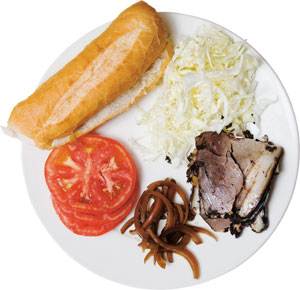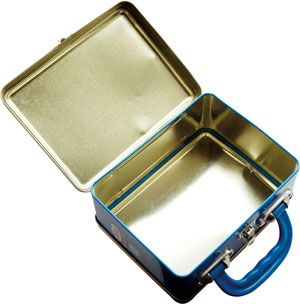 I always thought that the best thing about September was the return of the lunchbox. There was something mysterious and gratifying about a lunch served in a box. When we moved to the States, there were a few disastrous attempts to pack rice and stir-fried tomato and egg for lunch. Students didn’t have access to microwaves in large school cafeterias, and no one took kindly to my weird, non-bologna sandwich lunch. As a matter of survival, I stood in line with everyone else and bought rubbery pizza instead. Sometimes, though, when my grandmother made some of her great slow-stewed beef (jiangniurou), I would take a few slices, put it in between some unearthly pale Wonder Bread, and bring it to school. My sandwich looked like everyone else’s, but I knew better. I enjoyed that subversive thrill.
I always thought that the best thing about September was the return of the lunchbox. There was something mysterious and gratifying about a lunch served in a box. When we moved to the States, there were a few disastrous attempts to pack rice and stir-fried tomato and egg for lunch. Students didn’t have access to microwaves in large school cafeterias, and no one took kindly to my weird, non-bologna sandwich lunch. As a matter of survival, I stood in line with everyone else and bought rubbery pizza instead. Sometimes, though, when my grandmother made some of her great slow-stewed beef (jiangniurou), I would take a few slices, put it in between some unearthly pale Wonder Bread, and bring it to school. My sandwich looked like everyone else’s, but I knew better. I enjoyed that subversive thrill.
There’s always been a Chinese makeshift version of the sandwich: a fluffy white mantou, or steamed bun, smeared with some mouth-puckeringly savory fermented tofu, and some cold cuts of slow-stewed pork or beef. Kind of like a pulled pork sandwich. And of course, there’s the roujiamo, or, as my boyfriend lovingly calls it, the Roger Moore. This is why I’m always so surprised few people delve into making sandwiches with local cold cuts. The obvious choices are versions of my grandmother’s beef, or a similar cold cut, zhouzi, or slow-stewed pork knuckle, flavored with cinnamon and star anise. There really should be no contest between a processed, chemically engineered ham or bologna slice that has flown half way around the world and a locally raised pig, stewed slowly for hours until its meat is meltingly tender, juicy, and perfumed with spices.
 My favorite place for cold cuts is Daoxiangcun, an old name in Beijing deli shops, recognizable by its red and green storefront. They’ve got branches all over Beijing and are consistently reliable for very well-made cold meats, frozen jiaozi, quality butchery and bakery. My favorite is the slow-stewed pork knuckle, deboned and retied into sliceable chunks, called jiangzhouzi. You can ask them to slice it for you. It is definitely sneakable between a few slices of white bread, maybe with some sliced tomato for any grade school lunchbox. Here’s a more sophisticated version of that sandwich, paired with pickled onions in Chinese vinegar to cut the richness of the pork and a slightly sweet horseradish cabbage slaw. The onions can be made in a large batch and will keep for at least two weeks in the fridge. They are delicious in salads and any other kinds of sandwiches.
My favorite place for cold cuts is Daoxiangcun, an old name in Beijing deli shops, recognizable by its red and green storefront. They’ve got branches all over Beijing and are consistently reliable for very well-made cold meats, frozen jiaozi, quality butchery and bakery. My favorite is the slow-stewed pork knuckle, deboned and retied into sliceable chunks, called jiangzhouzi. You can ask them to slice it for you. It is definitely sneakable between a few slices of white bread, maybe with some sliced tomato for any grade school lunchbox. Here’s a more sophisticated version of that sandwich, paired with pickled onions in Chinese vinegar to cut the richness of the pork and a slightly sweet horseradish cabbage slaw. The onions can be made in a large batch and will keep for at least two weeks in the fridge. They are delicious in salads and any other kinds of sandwiches.
 Pickled onions
Pickled onions
2 large red onions
2 cup Chinese vinegar
1 bay leaf
3 Sichuan peppercorns
4 cups water
Slice red onions thinly. In a pot, boil four cups of water. Place onions in colander with bay leaf and peppercorns. Pour boiling water over onions and spices; shake colander for even distribution. Place onions and spices in a plastic container, cover with vinegar. Refrigerate at least two hours, or overnight. Remove onions from mixture to place on sandwich.
 Sandwich Prep
Sandwich Prep
4 or 5 slices of jiangzhouzi, or any other kind of rich cold cut
2 or 3 slices of ripe tomato
Cabbage slaw
Mustard
Pickled onions
Crusty baguette
Spread mustard and a few splashes of the pickling vinegar on the bread. Assemble sandwich. If intended for lunch, pack tomatoes separately and add to sandwich right before eating. The crustier the bread, the more likely it will hold up and avoid becoming soggy.



